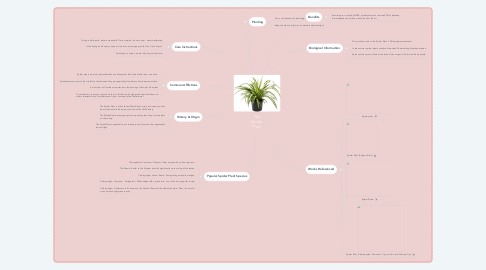The Spider Plant
by Ivan Ho

1. Common Afflictions
1.1. Spider plants are almost indestructible as a houseplant but it does suffer from one issue.
1.2. Spider plants are part of the Lily family of plants and they are especially vulnerable to fluoride accumulation.
1.3. An indicator of fluoride accumulation is the burning of the tips of the plant
1.4. To combat this, repot your plant in fresh soil, fertilize it with high-grade liquid fertilizer and collect rainwater for your spider plants if your community fluoridates water.
2. History & Origin
2.1. The Spider Plant is of South and West African origin and seems to have been introduced to Europe by the end of the 18th Century
2.2. The Spider Plant became popular as a parlour plant, hung from baskets on the ceiling.
2.3. The Spider Plant originated as rain forest ground cover and thus appreciates indirect light.
3. Care Instructions
3.1. During initial growth, water occasionally. Once matured - about a year - water moderately.
3.2. In the Spring and Summer, keep soil moist to encourage growth. Don't let it dry out.
3.3. Fertilize up to twice a month in Spring and Summer.
4. Planting
4.1. Use a soil-based, well draining potting mix.
4.2. Keep the plant in bright to moderate indirect sunlight.
5. Popular Spider Plant Species
5.1. Chlorophytum Comosum 'Vittatum'; Green edges with a white strip core.
5.2. The Bonnie; Similar to the Vittatum but with significantly more curling of the leaves.
5.3. Chlorophytum Laxum 'Zebra'; Fast growing with yellow edges.
5.4. Chlorophytum Comosum 'Variegatum'; White edges with a green core, one of the most popular variety.
5.5. Chlorophytum Viridescens; Also known as the Golden Glow and the Hawaiian Spider Plant, it is small in size and has bright green leaves.
6. Biological Information
6.1. The scientific name of the Spider Plant is Chlorophytum comosum.
6.2. In the summer, spider plants produce dime-sized flowers along branched scapes.
6.3. Spider plants sprout offsets at the ends of the scapes; fully formed 'baby' plants.
7. Works Referenced
7.1. Spider plant
7.2. Spider Plant (Airplane Plant)
7.3. Spider Plants
7.4. Spider Plant (Chlorophytum Comosum) - Types, Care and Growing Tips
8. Benefits
8.1. According to a study by NASA, spider plants can remove 95% of benzene, formaldehyde and carbon monoxide from the air.


